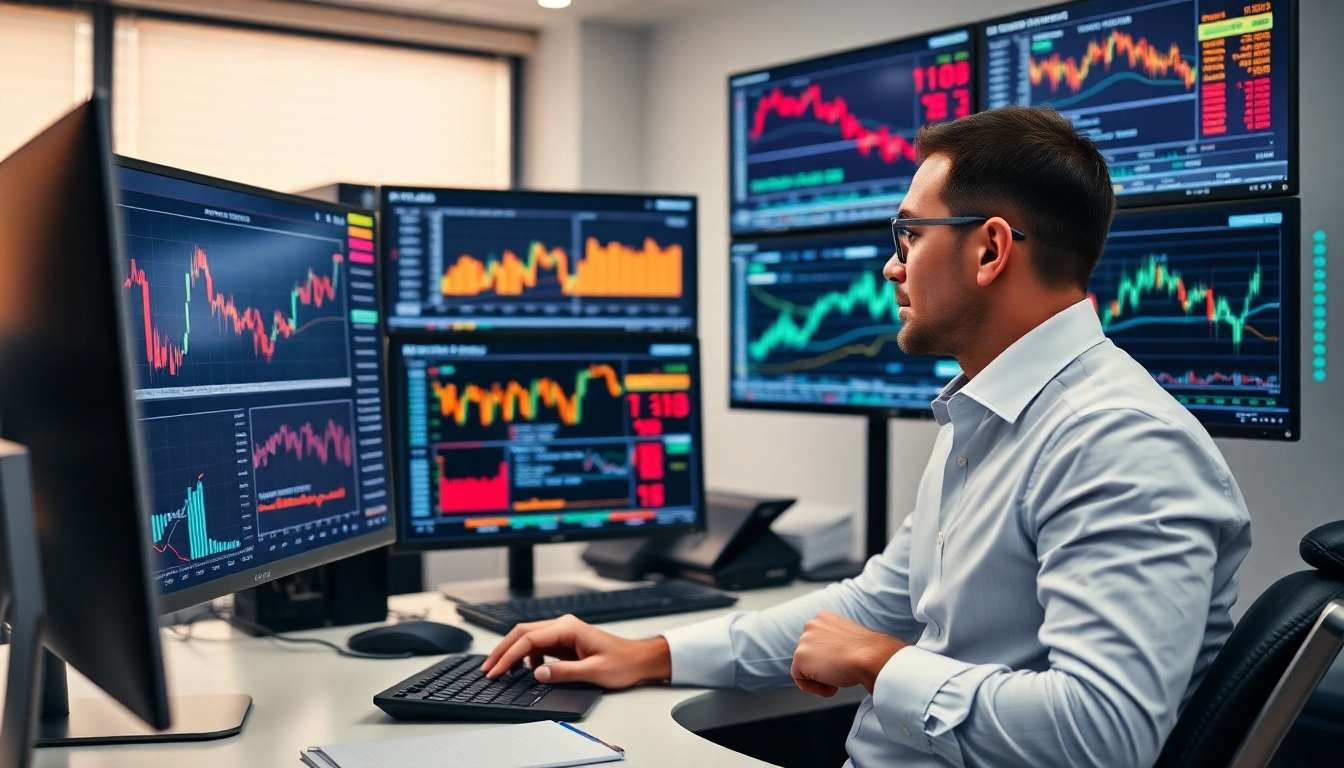Comprehensive Overview of Trading and Investment News: Markets Mix, Gold Reaches New Highs

Analyzing Current Market Conditions and Trends
Understanding Market Fluctuations and Sector Performance
The global financial landscape remains highly dynamic, characterized by mixed stock market performances and fluctuating commodity prices. Recently, European shares closed marginally higher, buoyed by sectors such as defense, reflecting investor optimism amidst ongoing geopolitical tensions. Conversely, U.S. markets experienced a slight decline, influenced by evolving trade policies and internal economic indicators. Sector performance varies significantly; technology stocks surged due to artificial intelligence advancements and strategic partnerships, while energy and mining sectors faced pressure from commodity price shifts.
To navigate these fluctuations, traders should employ sector rotation strategies, emphasizing sectors with strong fundamentals and growth prospects. Analyzing detailed sector performance reports, such as the STOXX 600 sector breakdowns, enables identifying resilient areas and adjusting portfolios accordingly. The recent rally in gold, driven by economic uncertainty and inflation concerns, highlights the importance of diversifying assets beyond equities. Understanding sector-specific catalysts, such as regulatory changes or technological innovations, can guide strategic investments in volatile markets.
Impact of Global Economic Indicators on Trading Patterns
Economic indicators act as crucial signals influencing market directions. For example, recent U.S. labor data, indicating steady employment growth, contributed to a cautious optimism in the markets, prompting shifts in dollar valuation and bond yields. Meanwhile, inflation readings in the U.S. have sustained investor concern, affecting Federal Reserve policy expectations. European economies showed resilience with marginal growth, but China’s weak data, particularly on manufacturing output, weighed on commodities like iron ore and oil.
Global economic indicators such as GDP growth rates, inflation, unemployment figures, and manufacturing indices serve as foundational datasets for traders. They influence decision-making by highlighting economic health and potential monetary policy shifts. For instance, expectations of U.S. Federal Reserve rate cuts, driven by positive labor data, bolster equities while slightly weakening the dollar. Traders should track these indicators continuously through trusted sources like government releases and financial news portals to fine-tune their strategies.
Interpreting Mixed Market Signals for Strategic Decisions
The current environment presents a tapestry of mixed signals; while certain markets incline upwards, others remain in consolidation or decline. Interpreting these requires a nuanced approach. For example, the marginal gain in European shares amid ongoing geopolitical tensions indicates investor caution paired with selective optimism. Conversely, gold reaching historic highs suggests hedging against inflation and currency volatility.
Strategies such as ratio analysis, technical charting, and sentiment analysis can help decipher these signals. A balanced approach considers both macroeconomic fundamentals and technical indicators. Incorporating tools like moving averages, trendlines, and volume analysis improves decision accuracy. For example, observing Bitcoin’s trendline confirms a potential bullish phase if it stays above the 200-week moving average, reinforcing long-term investing confidence.
Gold and Cryptocurrency Market Developments
Factors Driving Gold to New Record Levels
Gold continues its historic rally, reaching new record prices—an ounce soaring beyond $3,500—driven by multiple factors. Heightened inflation expectations, especially amid US inflation data, and geopolitical uncertainties magnify demand for safe-haven assets. The dollar’s slight decline further bolsters gold’s appeal, as investors seek alternatives to fiat currencies vulnerable to monetary easing policies. Additionally, central banks’ diversification efforts into gold as a reserve asset contribute to ongoing bullish momentum.
Moreover, macroeconomic policies, such as proposed US rate cuts and global economic slowdown signals, reinforce gold’s attractiveness. Analyst consensus suggests that as long as inflation fears persist, gold prices will remain under upward pressure. Strategic investors should consider the timing of market entry, leveraging technical breakouts and macroeconomic cues to optimize returns.
Cryptocurrency Trading Updates and SEC Influence
The cryptocurrency market exhibits a state of cautious optimism with flat performance in major tokens like Bitcoin and Ether, amid ongoing SEC regulatory scrutiny. Coinbase’s Q2 revenue decline, influenced by SEC actions, underscores the regulatory risks underpinning the digital asset space. MicroStrategy’s potential bitcoin accumulation hints at institutional confidence, yet unpredictable regulatory environments continue to induce volatility.
Recent developments include Meta exploring partnerships to enhance social media applications, integrating AI models, which could influence the future utility of digital assets. Traders should watch regulatory signals, as stricter oversight or potential bans could dampen market sentiment. Nonetheless, technological innovation, such as DeFi and blockchain upgrades, offers long-term growth opportunities for savvy investors.
Correlation Between Gold and Digital Assets in Current Trading News
During periods of economic uncertainty, correlations between gold and cryptocurrencies often intensify. Gold traditionally acts as a hedge against inflation and currency devaluation, while digital assets are increasingly viewed as alternative stores of value. Currently, with gold reaching record heights amid inflation fears and crypto markets stabilizing, there’s a growing perception of digital assets as ‘digital gold.’
However, correlations fluctuate based on macroeconomic and regulatory environments. For instance, during SEC crackdowns, cryptocurrencies may exhibit negative correlation with gold due to risk aversion. Investors should monitor these relationships, employing diversified strategies that balance between physical assets and digital holdings to mitigate risks.
Influences from Major Financial Institutions and Policy Makers
Central Bank Policies and Their Effects on Markets
Central banks globally remain pivotal in shaping market trajectories. The Bank of England’s recent warning to Facebook over Libra’s UK release underscores regulatory caution toward digital currencies, influencing investor sentiment. Meanwhile, expectations of U.S. Federal Reserve rate cuts in response to labor data have led to a weakening dollar and rising equity markets.
Policy signals, such as interest rate adjustments, quantitative easing, and regulatory frameworks, directly impact liquidity, risk appetite, and asset prices. Traders should monitor central bank statements and policy meetings for cues, adjusting positions to capitalize on anticipated policy shifts. For example, dovish central bank stances typically enhance equity and precious metal valuations.
Regulatory Updates Impacting Trading and Investment Strategies
Regulatory changes continue to reshape the trading landscape. The SEC’s actions on crypto trading platforms like Coinbase influence liquidity and investor confidence. The emergence of stricter conditions for digital asset offerings forces traders and platforms to adapt compliance measures swiftly.
Additionally, regulatory uniformity across jurisdictions, such as Europe’s evolving crypto rules, may facilitate broader adoption but pose compliance challenges. Staying informed through official regulatory announcements and engaging with compliance experts can help traders navigate complexities, ensuring adherence and optimizing market opportunities.
The Role of Geopolitical Events in Market Volatility
Geopolitical tensions, including US-China trade relations and regional conflicts, remain key drivers of volatility. Recent US calls for Fed officials’ resignation and tariff extensions on China-US trade reflect uncertainties that ripple through commodities, equities, and currencies. These events prompt safe-haven flows into gold and defensive stocks while pressuring riskier assets.
Risk management strategies, including hedging and diversification, are essential amidst such geopolitical risks. Investors should also consider geopolitical analysis reports and real-time news feeds to adjust exposure proactively and safeguard portfolios from adverse shocks.
The Latest Trading and Investment Strategies
Adapting to Market Fluctuations with Innovative Tactics
In uncertain markets, agility and innovation are key. Techniques such as algorithmic trading, leveraging AI-driven analytics, and employing derivatives for hedging can enhance flexibility. Active traders benefit from adjusting stop-loss and take-profit levels dynamically based on real-time data, like oscillators and volume signals.
For longer-term investors, focusing on fundamental analysis—evaluating macroeconomic trends, corporate earnings, and sector resilience—can safeguard against volatility. Diversification into alternative assets such as commodities and digital coins provides further resilience during turbulent periods.
Using Market Data to Forecast Future Trends
Accurate forecasting relies on integrating various data points: economic indicators, sentiment analysis, geopolitical developments, and technical signals. Machine Learning models and big data analytics now enable precision in predicting market movements, allowing traders to anticipate reversals or continuations with greater confidence.
Case studies highlight success in using such models to identify emerging trends—e.g., early signals of gold rally driven by inflation data or cryptocurrency cycles predicted through network activity metrics. Continual refinement of predictive models enhances strategic accuracy.
Tools and Platforms Shaping Modern Trading News Analysis
Modern traders utilize platforms like Bloomberg Terminal, TradingView, and specialized analytics tools incorporating AI for real-time updates. These platforms aggregate news, financial data, and sentiment metrics into actionable insights. Social media monitoring platforms also detect developing narratives and market sentiment shifts rapidly.
Implementing automation, alerts, and customized dashboards enables traders to respond swiftly to market signals. The integration of AI algorithms that analyze news headlines for sentiment and predictive indicators is further transforming trading approaches, allowing proactive rather than reactive strategies.
Future Outlook and Performance Metrics
Predictions for Stock, Gold, and Crypto Markets
Based on recent data, stock markets are expected to exhibit continued resilience, particularly in sectors aligned with technological innovation and defense. Gold’s trajectory remains upward, driven by inflation concerns and geopolitical risks, potentially reaching new highs if macroeconomic conditions persist. Cryptocurrencies, after recent stabilization, could see bullish trajectories if regulatory ambiguities clear and institutional adoption accelerates.
However, market volatility will likely remain high, requiring traders to stay adaptable. Monitoring key support and resistance levels, economic releases, and global geopolitical events will be vital in refining forecasts and capitalizing on emerging opportunities.
Measuring Success Through Key Performance Indicators in Trading
Effective evaluation involves tracking metrics like annualized return, Sharpe ratio, maximum drawdown, and win-loss ratios. Consistent performance above benchmarks, alignment with risk appetite, and resilience during downturns serve as indicators of a robust trading strategy.
Utilizing trade analytics and journaling helps identify strengths and weaknesses, facilitating continuous improvement. Setting realistic goals and employing disciplined risk management—such as position sizing and stop-loss orders—ensures sustainable growth.
Strategies to Stay Ahead with Ongoing Updates in Trading and Investment News
Staying informed is paramount. Subscribing to trusted news sources, leveraging AI-driven alerts, and participating in professional trading communities provide competitive edges. Regularly reviewing economic calendars, geopolitical briefings, and market sentiment reports enables traders to anticipate changes rather than react impulsively.
Incorporating continuous education, such as webinars and expert analysis, alongside utilizing robust analytical tools, will empower traders to adapt swiftly to evolving conditions, maintaining a strategic advantage.


